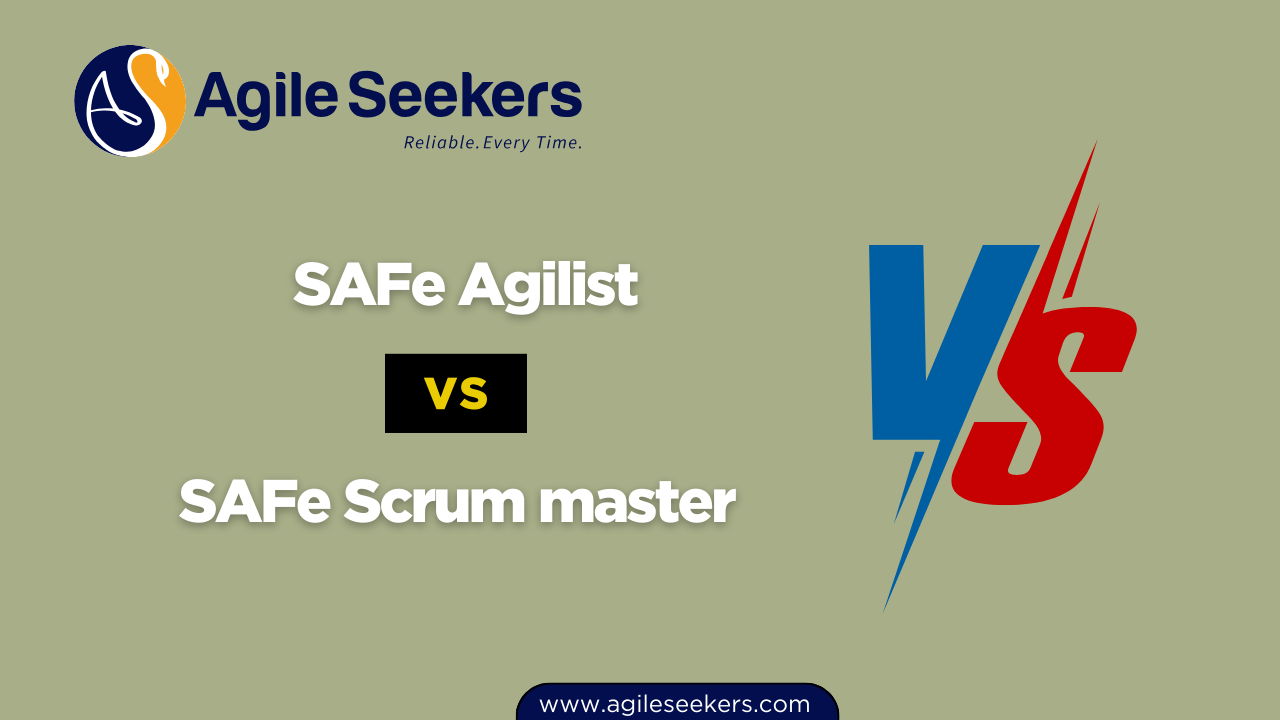SAFe Agilist vs SAFe Scrum Master - Which certification is Right for you

SAFe (Scaled Agile Framework) has established itself as a leading solution for organizations striving to scale Agile across teams. Two of the most popular certifications under SAFe are the SAFe Agilist (through the Leading SAFe course) and the SAFe Scrum Master (SSM). While both certifications are valuable, they serve different purposes and target different roles within the Agile ecosystem. If you are a professional trying to decide between these two paths, this detailed comparison will help you make an informed decision.
Understanding the Certifications
SAFe Agilist (Leading SAFe Certification)
The SAFe Agilist certification is earned by completing the Leading SAFe Training. This course equips individuals with the knowledge to lead Agile transformations within an enterprise using the SAFe framework. The focus is on adopting a Lean-Agile mindset, implementing SAFe principles, and managing large-scale Agile projects.
This certification is ideal for senior roles such as Agile coaches, executives, product managers, and release train engineers. It provides a high-level overview of SAFe implementation, Lean Portfolio Management, Agile Product Delivery, and organizational agility.
SAFe Scrum Master (SSM Certification)
The SAFe Scrum Master certification is tailored for Scrum Masters operating in a SAFe enterprise. Unlike traditional Scrum Master training that focuses on the team level, the SAFe Scrum Master course prepares professionals to work within Agile Release Trains (ARTs) and facilitates Scrum throughout the enterprise.
The SSM Certification helps professionals understand the role of a Scrum Master in a SAFe context, including iteration planning, PI planning, coaching Agile teams, and removing impediments across teams.
Key Differences Between SAFe Agilist and SAFe Scrum Master
1. Role and Responsibility Focus
- SAFe Agilist: Geared toward strategic and leadership roles. Agilists focus on guiding enterprise-level Agile adoption, aligning business goals with Agile principles, and fostering Lean-Agile leadership.
- SAFe Scrum Master: Centered on team-level execution and facilitation. Scrum Masters coach Agile teams, ensure proper implementation of Scrum practices, and support team performance within the SAFe structure.
2. Audience
- SAFe Agilist Certification: Best suited for leaders, senior managers, program managers, change agents, and executives looking to scale Agile practices across departments.
- SAFe Scrum Master Certification: Ideal for aspiring or current Scrum Masters, Agile team facilitators, project managers, and team leads.
3. Curriculum and Learning Objectives
- Leading SAFe Training: Covers SAFe principles, Lean-Agile leadership, Agile Release Trains (ARTs), Lean Portfolio Management, and enterprise-level agility. It includes strategies for implementing and sustaining SAFe.
- SAFe Scrum Master Course: Focuses on SAFe Scrum, team roles, iteration planning, flow, Kanban for teams, and facilitating Program Increment (PI) planning.
4. Certification Prerequisites
- Leading SAFe Certification: While there are no mandatory prerequisites, having 5+ years of experience in software development, testing, business analysis, or product/project management is recommended. Experience with Scrum is also beneficial.
- SSM Certification: No mandatory prerequisites, though familiarity with Agile concepts, Scrum, and SAFe is helpful.
5. Career Path and Growth
- SAFe Agilist: Opens doors to leadership roles such as Release Train Engineer, SAFe Program Consultant (SPC), Agile Coach, and Lean Portfolio Manager. It's a stepping stone to becoming a strategic change leader.
- SAFe Scrum Master: Lays the foundation for future roles like Senior Scrum Master, RTE, or Agile Coach. It is a practical and team-focused certification that can lead to mid-level leadership roles.
Which Certification Should You Choose?
Choose SAFe Agilist If:
- You aspire to lead enterprise-level Agile transformation.
- You hold or aim for leadership, strategic, or managerial roles.
- You want to influence organizational structure, portfolio management, and business agility.
- You need a broader understanding of SAFe implementation across the enterprise.
- Explore more about the SAFe Agilist Certification to evaluate its benefits for your career path.
Choose SAFe Scrum Master If:
- You are passionate about Agile team facilitation and delivery.
- You currently work as a Scrum Master or want to become one.
- You want to gain practical, team-level skills aligned with the SAFe framework.
- You’re looking for hands-on experience in PI planning, iteration execution, and team coaching.
Dive deeper into the SAFe Scrum Master certification to understand its role in scaled Agile teams.
Final Thoughts
Both SAFe Agilist and SAFe Scrum Master certifications offer immense value, but the right choice depends on your current role, career goals, and interests. If you envision yourself driving Agile transformation at an organizational level, the Leading SAFe certification is the way forward. However, if you're looking to build expertise in Agile team dynamics and become a strong team-level leader, the SSM Certification will set the foundation.
Whichever path you choose, both certifications reflect a strong commitment to excellence in the Agile world and can significantly boost your career prospects.
To learn more about upcoming training schedules, visit AgileSeekers and explore how these certifications can shape your Agile journey.
Also Check the Cost of SAFe Agile certification
Also Read the Benefits of SAFe Agile certification




















